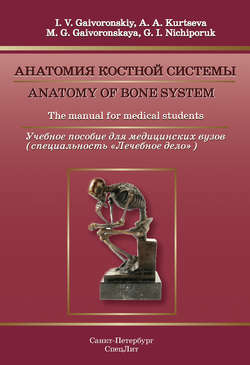Читать книгу Anatomy of bone system. The manual for medical students / Анатомия костной системы. Учебное пособие для медицинских вузов - Г. И. Ничипорук - Страница 8
1. GENERAL ОSTEOLOGY
1.4. External Structure of Bones
ОглавлениеWhile describing the external structure of bones, we should pay attention to the surfaces, facies, of the bones, which may be flat, concave or convex, smooth or rough. Articular surfaces facies articularis, involved in formation of joints, are the most smoothly polished ones. In some bones the end is rounded, forming a head – caput; at the same time, the end of other bones has concavity, called articular fossa, or fossa articularis. The head may be separated from the bone body with a constricted part – neck, collum. If the articular end is extensive but slightly curved surface, it is termed condyle, condilus. The processes located near the condyle are named epicondyles, epicondyli, they serve for attachment of tendons and ligaments (they may also be called apophyses).
The following surfaces are distinguished in bones (depending on theirlocation in the human body): internal or external, medial or lateral etc. The surfaces are separated by borders, margo. The borders, in turn, are known as superior or inferior, medial or lateral etc. They may be smooth or serrated, blunt or sharp, sometimes they have notches, incisurae, of different sizes.
On the surfaces of bones, there may be such formations as: processes, eminences, depressions, openings etc. (bone process, processus; elevation, eminence, eminentia; large rounded elevation or tuberosity, tuberositas; hillock, tuber; bulge, protuberance, protuberantia; tubercle, tuberculum; sharp process – spine, spina; crest, crista; hollow in the bone, fossa; pit, foveola; groove, sulcus, opening, foramen; canal, canalis; small canal, canaliculus; fissure, fissura; cavity, cavitas).
